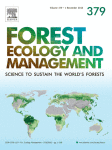Ver ítem
- xmlui.general.dspace_homeCentros Regionales y EEAsCentro Regional Patagonia SurEEA Santa CruzArtículos científicosxmlui.ArtifactBrowser.ItemViewer.trail
- Inicio
- Centros Regionales y EEAs
- Centro Regional Patagonia Sur
- EEA Santa Cruz
- Artículos científicos
- Ver ítem
Allometric relations for biomass partitioning of Nothofagus antarctica trees of different crown classes over a site quality gradient
Resumen
Data on tree biomass are essential for understanding the forest carbon cycle and plant adaptations to the environment. We determined biomass accumulation and allometric relationships in the partitioning of biomass between aboveground woody biomass, leaves and roots in Nothofagus antarctica. We measured above- and belowground biomass of N. antarctica trees across different ages (5–220 years) and crown classes (dominant, codominant, intermediate and
[ver mas...]
Data on tree biomass are essential for understanding the forest carbon cycle and plant adaptations to the environment. We determined biomass accumulation and allometric relationships in the partitioning of biomass between aboveground woody biomass, leaves and roots in Nothofagus antarctica. We measured above- and belowground biomass of N. antarctica trees across different ages (5–220 years) and crown classes (dominant, codominant, intermediate and suppressed) in three site qualities. The biomass allocation patterns were studied by fitting allometric functions in biomass partitioning between leaves (ML), stem and branches (MS) and roots (MR). These patterns were tested for all pooled data and according to site quality and crown classes. Biomass accumulation varied with crown class and site quality. The root component represented 26–72% of the total biomass depending on age and site. N. antarctica scaling exponents for the relationships ML vs. MS, MA vs. MR, and MS vs. MR were close to those predicted by the allometric biomass partitioning model. However, when biomass allocation was analyzed by site quality the scaling exponents varied following the optimal partitioning theory which states that plants should allocate more biomass to the part of the plant that acquires the most limiting resource. In contrast, the crown class effect on biomass partitioning was almost negligible. In conclusion, to obtain accurate estimations of biomass in N. antarctica trees the allometric approach appears as an useful tool but the site quality should be taken into consideration.
[Cerrar]

Autor
Gargaglione, Veronica Beatriz;
Peri, Pablo Luis;
Rubio, Gerardo;
Fuente
Forest Ecology and Management 259 (6) : 1118-1126 (March 2010)
Fecha
2010-03
Editorial
Elsevier
ISSN
0378-1127
Formato
pdf
Tipo de documento
artículo
Palabras Claves
Derechos de acceso
Restringido
 Excepto donde se diga explicitamente, este item se publica bajo la siguiente descripción: Creative Commons Attribution-NonCommercial-ShareAlike 2.5 Unported (CC BY-NC-SA 2.5)
Excepto donde se diga explicitamente, este item se publica bajo la siguiente descripción: Creative Commons Attribution-NonCommercial-ShareAlike 2.5 Unported (CC BY-NC-SA 2.5)

